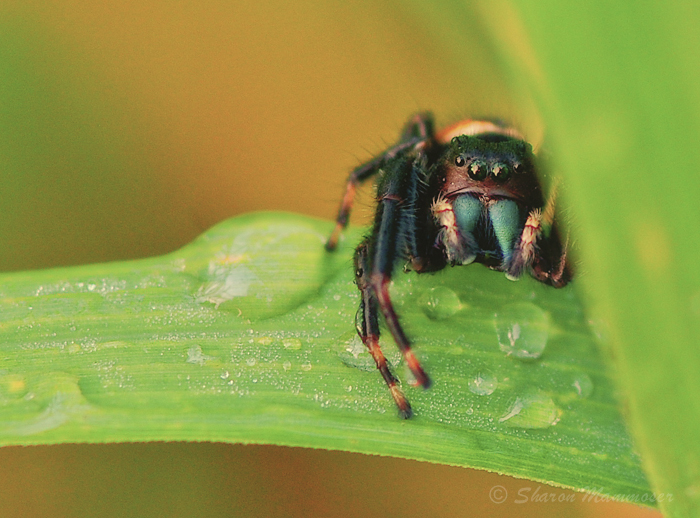 When I sit down and disappear into the grass, getting eye-level with a variety of creatures who live there, I get excited when I spot a jumping spider, my favorite of all the spiders. Recognizable by the two large middle front eyes, these spiders appear almost child-like in what I can only describe as curiosity.
When I sit down and disappear into the grass, getting eye-level with a variety of creatures who live there, I get excited when I spot a jumping spider, my favorite of all the spiders. Recognizable by the two large middle front eyes, these spiders appear almost child-like in what I can only describe as curiosity. 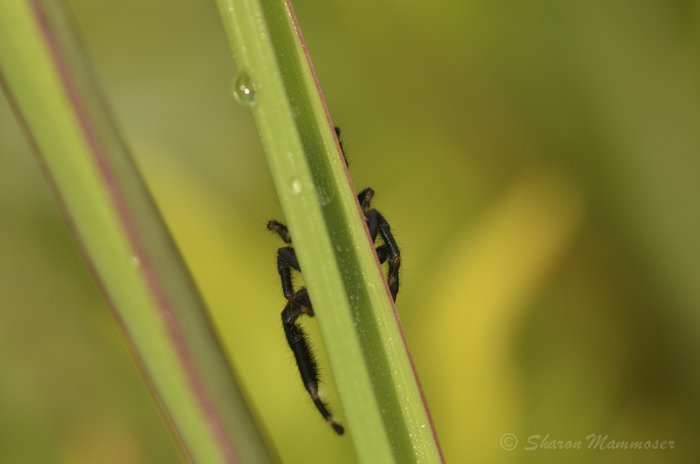
When I see one it almost always sees me too (because wow, they have good vision) and will quickly dash behind a leaf or plant stem, oblivious that their legs might be hanging out on the sides and that they haven’t actually disappeared. I take this as my cue to quickly get my camera and tripod situated, knowing from experience that the chances are high he will wait a few minutes, and then, very slowly, turn and peek around the obstacle, to see if I am still there. Usually what I will see as he is looking back my way are his four front eyes, hairy pedipalps and often iridescent fangs. Like a child hiding behind the couch, this action makes me smile. Sometimes I may move my hand close to him, hoping he will leap onto it so I can bring him closer for a better look. Surely realizing I am WAY too big to eat, the spider scurries around, keeping me in view with his big eyes. I don’t worry that he will bite me–this is rare for spiders to do despite popular belief to the contrary. After I have watched him long enough and gotten my share of pictures, I will set him back where I got him and go on my merry way. 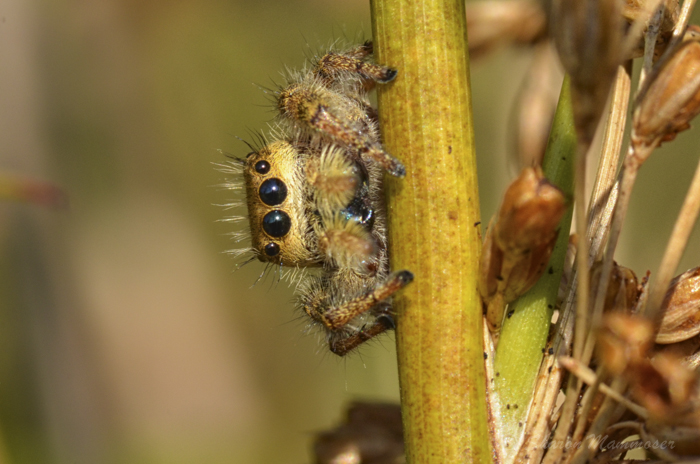
Here are some interesting things you may not know about jumping spiders:
- Like all spiders, jumping spiders have two body parts–one called a cephalothorax, where 4 pairs of legs are attached, and the other an abdomen. They also have a pair of what looks like mini legs–called pedipalps. These grab prey, maneuver it into the mouth and in males, become sexual organs when mating. Like other spiders, they produce silk and have 8 eyes, four in front and two tiny eyes on each side of their cephalothorax.
- Many spiders are hard to identify without a microscope, but all jumping spiders have two big eyes set between two smaller eyes in the front of their bodies. These eyes are often iridescent, especially colorful when the sunlight hits them just right.
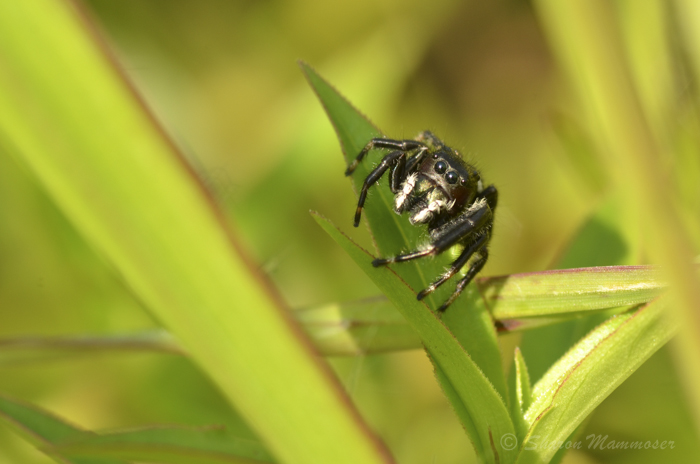
- The latin name of jumping spiders is Salticidae, from the latin word, Salto, which means to dance. This is a great name for them as they partake in a funny and sometimes bizarre dance before mating. The males, who are generally more brightly colored than the females, will wave their legs, move their pedipalps and sometimes shift from side to side. A watching female, if interested, may dance back, seemingly to communicate that she likes his moves and wants to see more! There’s a FABULOUS video of an amazingly colorful jumping spider that lives in Australia doing this–Click HERE to see. It is the most colorful spider I have ever seen!
- Jumping spiders are small in comparison to some other kinds of spiders, just 3-17mm in length.
- Despite their small size, they are capable of bringing down much larger prey. They do not build a web to catch their prey, instead they are the tigers of the invertebrate world. Active during the day, they stalk and then pounce on creatures like butterflies, crickets, grasshoppers, flies, and other insects, quickly injecting them with a fast-acting venom. Of course, just in case, they secure a safety line of silk before jumping so they can easily return to safely should the need arise. Sometimes called a dragline, this is typical of spiders.
- Jumping spiders are the largest family of spiders, with more than 5,000 species. Scientists have named 50,000 different kinds of spiders, though they believe this is only about 1/10th of all those that exist.
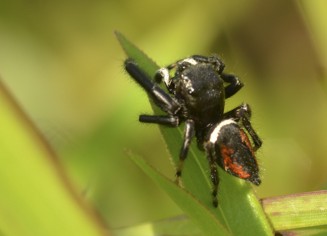
- Like other spiders and insects, jumping spiders grow by molting, or shedding their skin. Most jumping spiders will molt 5 or 6 times before becoming adults.
- Some jumping spiders are capable of jumping 50 times their height! This is amazing considering that they do not have extra long legs like a frog or cricket. Scientists have learned that they accomplish these big leaps by creating a sudden change in blood (called hemolymph in insects and spiders) pressure. When they want to jump, they contract muscles in the upper and lower plates of their cephalothorax, thus decreasing volume of blood in that region and instantly pumping a surge of blood to their legs. This cause them to spring forward suddenly.
- Jumping spiders see in color and have acute eyesight. With their 8 eyes in the front and on the side of their cephalothorax, they can see well in most directions. It is hard to sneak up on a jumping spider!
- Jumping spiders do not build webs but do produce silk. They use this to protect their eggs, as draglines and to create silken chambers in which they will sometimes hide during the night.
If you are interested in learning more about spiders, check out my Spider Myths Debunked page or CLICK HERE to look at some spiders that I captured with the lens of my camera.
[simpleSubscribeForm]



I absolutely share your love of the adorable jumping spider. Just this afternoon I witnessed first what I thought might have been some courtship between two, but I think they realized they were both boys and one of the two dropped like a rock off of the picnic table they were both occupying (they got to within about 2 inches of each other when the one decided to go splitzville in a hurry, lol). But then that one that dropped off the table proceeded to stalk and pounce on a fly, right before mine eyes! OMG it was AMAZING! I wish more than anything that I’d had a camera (video) to capture the 20 minute encounter (between the pedipalp waving curiosity of the two on the table, to the first one patiently stalking its prey on the ground).
Love your photos! Living in WA now, I’ve attempted to take pics of the quite large Bold/Daring jumping spiders we have out here, but they don’t like cameras, lol. One actually jumped at my lens! I could just imagine what he was saying, “DARN PAPARAZZI!”
Anyway, I wanted to share my story and let you know that there are plenty of others out here who respect and admire these cute little furry predators as much as you do.
Best,
-Kim-
Kim, thanks for writing! I loved your story– could totally picture it from your description. It would have been great to film it! But challenging too as they are so small. I am glad there are others out there who share my interest and fascination of these most- cute spiders! Thanks for letting me know I am not alone.
Glad you liked the story/description. It really was fascinating observing such a range of behavior in such a short period of time. I’m curious… would you mind telling me what camera equipment you use? I’ll probably soon be upgrading my camera (I do landscape and botanical photography…including the occasional insect/spider on some garden plants). I’m always interested in knowing what others are shooting with.
BTW, some years ago when I lived in Southern California I witnessed an equally amazing example of insect predatory behavior. It was the spring, the roses were blooming, the aphids were out en force, and the ladybugs were not yet available at the hardware store. I happened upon a ‘wild’ ladybug so I caught ‘her’ and put ‘her’ on a rose, very much infested by aphids. Well Ms. Ladybug musta been STARVING because no sooner did I place the little critter on the rose next to some aphids did I observe said Ladybug to IMMEDIATELY POUNCE ON A FAT JUICY APHID AND PROCEED TO DEVOUR IT! I mean, I knew, like most, that ladybugs eat aphids, but I’d never actually SEEN it happen! Most think of ladybugs as these sweet, harmless, pretty little flying VW Beetles…not amazing predators! And it happened so fast! I think I laughed in utter amazement! Yet another missed brilliant photo op. I don’t think I’ve ever seen a photo or video of a ladybug chowing down on an aphid, lol.
I really wish more people would just stop and look more closely at the amazing world in their gardens and on their lawns and in the cracks in the sidewalk or between boards in their fences, etc. and learn not to be afraid of these amazing little creatures (I’m also a HUGE fan of mantids). Once I started gardening I slowly got over my deathly fear of bees. People rarely just STOP and think or observe and contemplate anymore. That makes me very sad for the human race.
Kim, I am shooting with a Nikon 7000. I have a 110 macro lens that I use along with a sturdy tripod. I prefer natural light so rarely use any kind of artificial lighting or flash. I often will use the tripod like a monopod when I am in a grassy place where it may be difficult to truly set up the tripod.
I have never seen a ladybug actually eating an aphid, though frequently I have seen the two together. I guess the ladybugs I have seen weren’t so desperate for a meal! Most people would be shocked to witness what you saw!! I agree that they think of them as cute bugs. I will do a post about them in the near future– great idea, thanks.
I so agree with you about people not ever taking the time to just LOOK or just BE. It makes me sad too, and powerless, though I do see wonderful examples of change or of people having their eyes opened to something in nature. This is one of my most motivating forced in doing this blog– I want to open people’s eyes and cause them to look at things differently. One person at a time is a slow way to make progress, but if that one person then changes or influences another two people and those two people influence three people…. Slow but steady we can make a difference. I do think people are becoming more aware and vocal about the need for a connection to the natural world, though it is really hard to compete with today’s technology.
As a child I was deathly afraid of both snakes and spiders and now enjoy watching and photographing and learning about both. Like your fear of bees, it shows change IS possible! Did you just decide not to be afraid anymore? Was it a long process?
The only things I was ever ‘afraid’ of as a child were bees/wasps. I got stung A LOT. I think when I started hearing about the plight of honey bees I started to cheer them on more in the garden. I was never afraid of bumble bees, of course. I’m not sure I knew the difference between bees and wasps/hornets as a child, though. Certainly working in the garden I’d be so preoccupied with what I was doing I wouldn’t pay attention to the bees and eventually I became accustomed to them and even more eventually, would enjoy watching them in flowers. There was a tree outside of my apartment in South Pasadena that would be buzzing with honey bees every spring. It was an amazing thing to walk out and under that tree and hear the bees hard at work overhead.
Another funny insect story… when I was working in LA, my workplace had lots of beautiful lillies planted everywhere. And in So Cal we also had big lumbering carpenter bees (big black fuzzy guys, like all black bumbles). One day I was walking to the office and I started noticing these MUTANT NEON ORANGE BEES! I thought to myself, “what the heck are those?!?!”… then as I approached the lilies, I realized it was the carpenter bees COVERED from ‘head to toe’ in lily pollen. It was hilarious! My friend, Brent, is an entomologist so I told him about it and he had a good laugh too. He said those guys are completely harmless and somewhat messy. Yeah, I’ll say! Of course, then Brent proceeded to tell me that he can tell the difference btwn male and female carpenter bees and one of them (I forget if it was M or F) you can just grab out of the air b/c it doesn’t have a stinger. But it’ll pretend to sting you with its butt! I told Brent I’ll leave that to him, since he can tell the difference, lol.
I started noticing other amazing critters in my garden too. Like a “Leaf Footed Bug”, a beautiful white crab spider, a gigantic and gorgeous lynx spider, baby praying mantises, and some really interesting katydid nymphs. I got pics of all of them. When you’re behind the camera it’s also easier to get up close and personal and appreciate them all more. You get to see the beautiful colors and amazing structures and behaviors.
My boyfriend gave me an amazing microscope for my birthday so I’m hoping to start doing some photography with that. I have some specific ideas related to plants (I love taking pics of plants and leaves, etc… especially cactus and cactus flowers. Cactus flowers are spectacular!)
For now I’m shooting with my first digital slr. It’s about 6 years old now, I think. I’m ready to upgrade since I’ve been discovering some of its limitations in the last 2 years. It’s just a Canon xSi Digital Rebel. I too found a really nice USED macro lens at a camera shop. The thing had never been used, by the looks of it, so I got it for about half what it would’ve cost new. It’s a nice piece of optics and I use it often.
Yes! Story on ladybugs would be great! Have you done any on mantids? Have you managed to take pics of any mantids? The baby ones are just too adorable!
Oh, one last story about overcoming fears. One night I was chatting with an astronomy buddy on the phone in So. Cal. He told me to go outside to look at something, so I ran out in my bare feet to the front yard, down the 4 concrete steps from the porch to the ground. After observing what Jim wanted me to see, I turned around only to see the biggest black widow spider hanging upside down between 2 steps… the same steps that I’d just sprinted down in bare feet! Well, I didn’t have the heart to kill her either, so the next day I donned some long sleeved gloves, a long sleeved shirt, pants, boots… and a broom. There were some flower pots with lots of leaf-litter collected between them, which is of course where the spider was residing during the day. One by one I pushed the pots away from the side of the steps with the broom, gently brushing away the leaf litter until I found lady spider. She was hiding under a clump of leaves. I went inside, got a large jar, and mustering all of the courage I could muster, I placed the jar on top of the clump of leaves and slid a piece of cardboard underneath to catch the spider. Once she was secured in the jar, I could get a good look at her. First, she was HUGE. I had no idea black widows could get so large, and this was the first one I’d ever seen in my life. But then as I turned the jar over and over to try to look at her, she would scurry behind leaves out of fear and to hide herself. She was very shy. I did get some good looks at her and was immediately struck by how beautiful she actually was. Now, keep in mind, I’m also a big shark lover (I like the predators, for some reason, lol). I thought of this spider as the great white shark of the spider world. Perfectly and beautifully designed for what she’s supposed to do. That opportunity to admire her while feeling safe was really invaluable. I cleaned up the rest of the stairs so that no more spiders would want to live there, and then I released the big black widow into a secluded part of the garden where she’d be able to find lots of food and not bother anyone else.
People have to be open minded and willing to confront their fears. The rewards are often far more powerful than the fear itself was. After that widow encounter, whenever I’d see one, I’d relocate it. At work, people know to call me if they find a strange bug in their office. They know I’ll catch and release it. Haha, even my BOSS has gotten into it! We have these large black beetles here too. My boss told me that one day when I was out, she found one crawling in the kitchen, and, thinking of ME, rather than killing it, she managed to catch it and let it back outside. I’d say that’s a huge victory! So you are right. One person at a time. That’s all we can do. But it’s one more than before.
I lived reading your stories! And yes, I have watched and gotten great shots if praying mantises. They are a cool insect! I saw a black widow spider only once in my life– in Colorado. She had an egg sac with her and was very protective of it. Someone found her in their yard and put her in a jar and then brought her to the nature center where I worked. I ended up taking her to a safe place and releasing her. Of course I took some photos before I left her alone in her new home.
Lynx spiders are cool! I love seeing them and usually take pictures– even though I already have LOTS!
Good for you in relocating critters rather than killing them! We need more of us. Thanks for working with me on this…one person at a time.
How did you come to find the jumping spider post? If I remember right, it is many months old now.
“How did you come to find the jumping spider post? If I remember right, it is many months old now.”
I was trying to find out why the jumpers wave their pedipalps around and then I was trying to ID the spiders. I think I entered, “Juvenile bold/daring jumping spider”, and your blog was one of the posts that came up.
Even my boyfriend now knows that if he finds a spider in the house not to kill it… instead he’s to call me over so I can remove it, lol.
They wave their pedipalps as a courtship behavior, males trying to impress the females. “Look at me! Aren’t I attractive?” Some spiders are very elaborate about it.
It is funny that your boyfriend lets you remove the spiders!! That really is a lol.. A role reversal certainly. Good for you!! I am so happy to hear I am not alone in this. Remember, one person at a time!
Hope to hear from you again. Do you subscribe to my blog?